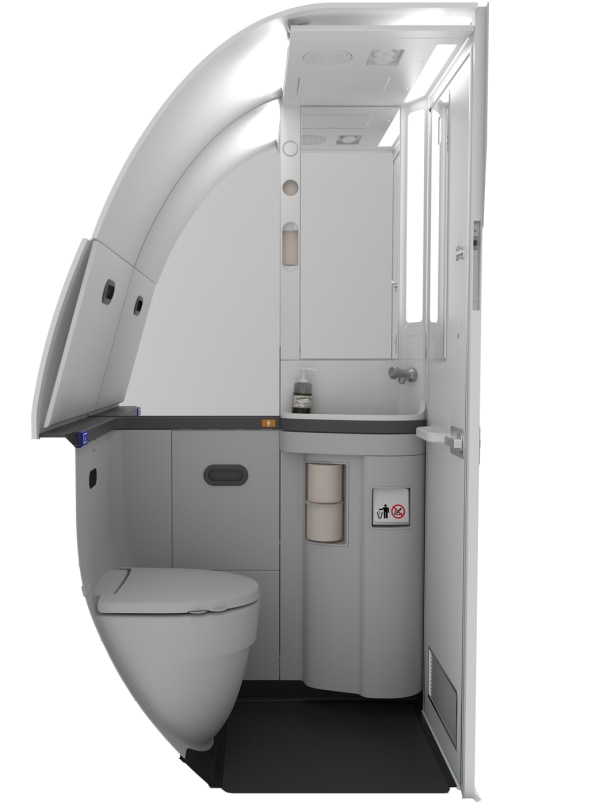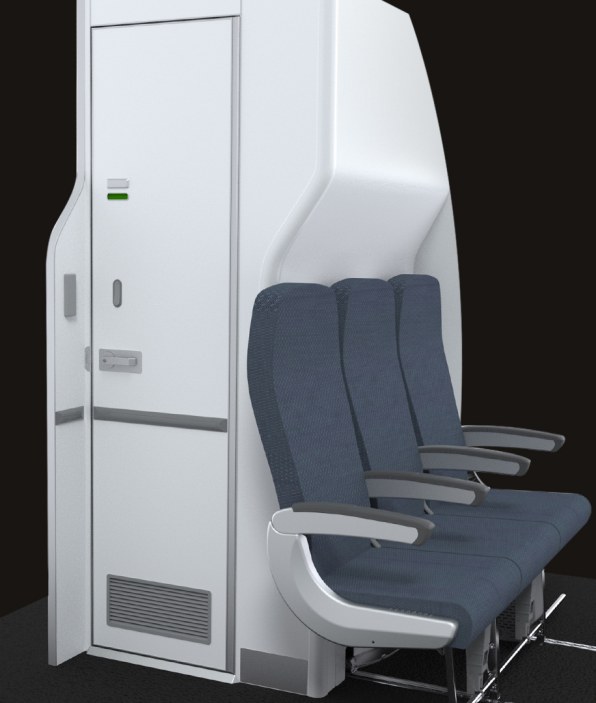That product exists, but it’s probably not what you’d expect. It’s a new, tinier, economy class airline bathroom called the 737 Advanced Lavatory, which you’ll find on up to 40% of new orders for the popular planes. Designed by the aviation and information technologies company Rockwell Collins for 737s, it buys airlines an additional seven inches of space in the cabin–a football field, in airline terms–sheerly through innovative design.
Yet that seven inches comes from the most precarious seat on the plane. So how are airlines that buy Rockwell’s toilets putting those newfound inches to use–are they using it to make their seats more comfortable, or using it to squeeze even more passengers onto the same planes? “The airlines have become dynamic with new business models,” says Trevor Skelly, VP and general manager at Rockwell Collins. “They can use that space however they wish.”
In other words, it’s controversial, rankling the public while delighting airlines. When the lavatory design was released to the public earlier this year, it was touted as a totem to aviation greed, a symbol of the last human right–defecating in peace–being robbed from the traveling public. And yet, the bathroom has been a hit with big business for a reason. In a world where fuel can be the most dynamic expense for airlines, the most efficient way to run an airline is dependent on cramming the most people in per mile.
DESIGNING THE HOT SEAT
Rockwell Collins designs many models of seat and bathroom for commercial airplanes. Given the increasing importance of space in the air, the firm’s work has largely focused on whittling away hardware components wherever possible, making planes lighter and increasing passenger counts. As Alex Pozzi, vice president for research and development in interior systems for Rockwell Collins, put it to the New York Times last year, “the less size that the seat structure itself takes up, the more space that’s left over for the passenger.”

This was two-dimensional thinking from a time when airplanes were laid out in two-dimensional floor plans. But with modern technologies–like 3D architectural renderings and VR simulations–designers can think about the ergonomics of flight in a whole other dimension.
“In our case, we didn’t reduce the footprint of the lavatory,” says Skelly. “Our innovation was to put a curved wall on the forward face of a lavatory, which in some installations, allows the seats in front [of the lavatory] to have full recline.” In other words, the 737 Advanced Lavatory is shaped like the negative space of a Lay-Z-Boy recliner so people seated in the plane can lean their backs into the bathroom’s air space.
Some of this seven-inch gap was found in the walls, rather than bathroom cabin itself; the designers discovered there was actually some dead space behind and above the mirror. And formerly, a flat wall was built out on both sides of the sink just to make it all one straight line–a five- to six-inch gap across much of the bathroom, which designers largely opened up. The person in the bathroom makes a compromise, but the cabin nets more space as a result. “We did encroach a little in the space inside the lavatory,” Skelly concedes, “but not to the extent we put a curve in the wall [for seats].”

TESTING WITH YOUR PANTS ON
Working alongside the air travel design firm Teague, Rockwell’s designers tested the ergonomics through several mockups built with flexible dimensions. Teague hosted focus groups in various shapes and sizes, from women in the 5th percentile of height and weight to men in the 95th percentile.
“We have a database of these users,” says Skelly. “We call them in. And we get them to go in, close the door, do different things.” The observers will often film video, too–which sounds weird, until you realize the testing is fully clothed. No one actually uses the toilet.
Eventually, Teague and Rockwell Collins figured out the most optimal ergonomic trade-offs. Yes, the new bathroom is smaller, but Skelly points out that its toilet space is larger, because designers cut into that sink wall, which would have butted against the left or right side of the toilet, depending on orientation. “In the seated position, for the 95th percentile guy, he has more knee room than in a traditional lavatory,” Skelly says.
In any case, while having a smaller airline bathroom sounds horrible all around, and most of us dread using a toilet in the sky in the first place, Skelly believes a little bit of misery is actually worth the larger trade-off.
“The person in that aftward [toilet abutting] seat who was sitting for five hours with no recline, will spend five minutes, hopefully, in the lavatory for the whole flight,” he says. Instead, that row of people next to the bathroom can recline. Or perhaps the seven inches are redistributed across three or four rows of seats, giving them all a bit more legroom.
“In some ways it democratizes the economy class of the airplane,” says Skelly.
IT’S YOUR BOTTOM VS. THEIR BOTTOM LINE
In some ways. But in truth, that seven inches is at the disposal of how the airlines themselves would like to use it, and airlines are notorious for maximizing profit above comfort. The space also opens the door for padding upsell options, like so-called premium economy seating. And in about 50% of cases, the geometry of the plane and seating can actually turn that seven inches into a whole additional row of seating.
“It’s really aligning with the business models–and, at the end of the day, why passengers fly low-cost airlines–it’s how they choose to spend their money. And these kinds of innovations are helping reduce the cost of travel in many cases,” says Skelly. When I openly question that mentality, positing that few of us truly choose to fly economy, but rather, we are forced to by the realities of our finances, he stands his ground.
“Well, you know, I don’t think so. I would disagree with that. I have friends with a lot of money and they choose to fly economy class. I’m flying economy class today to Europe. That’s my choice,” he says. “What I would say is, what we do is create, in conjunction with the airline, a lot of choice to what’s available out there . . . if users think lavatories are a problem on the airline, they can go to the front. Not every lavatory on the airplane has to be like this.”
source: https://www.fastcompany.com/90236107/its-not-just-you-heres-why-your-airplane-toilet-feels-tiny
by Mark Wilson
http://www.thisoldtoilet.com

No comments:
Post a Comment